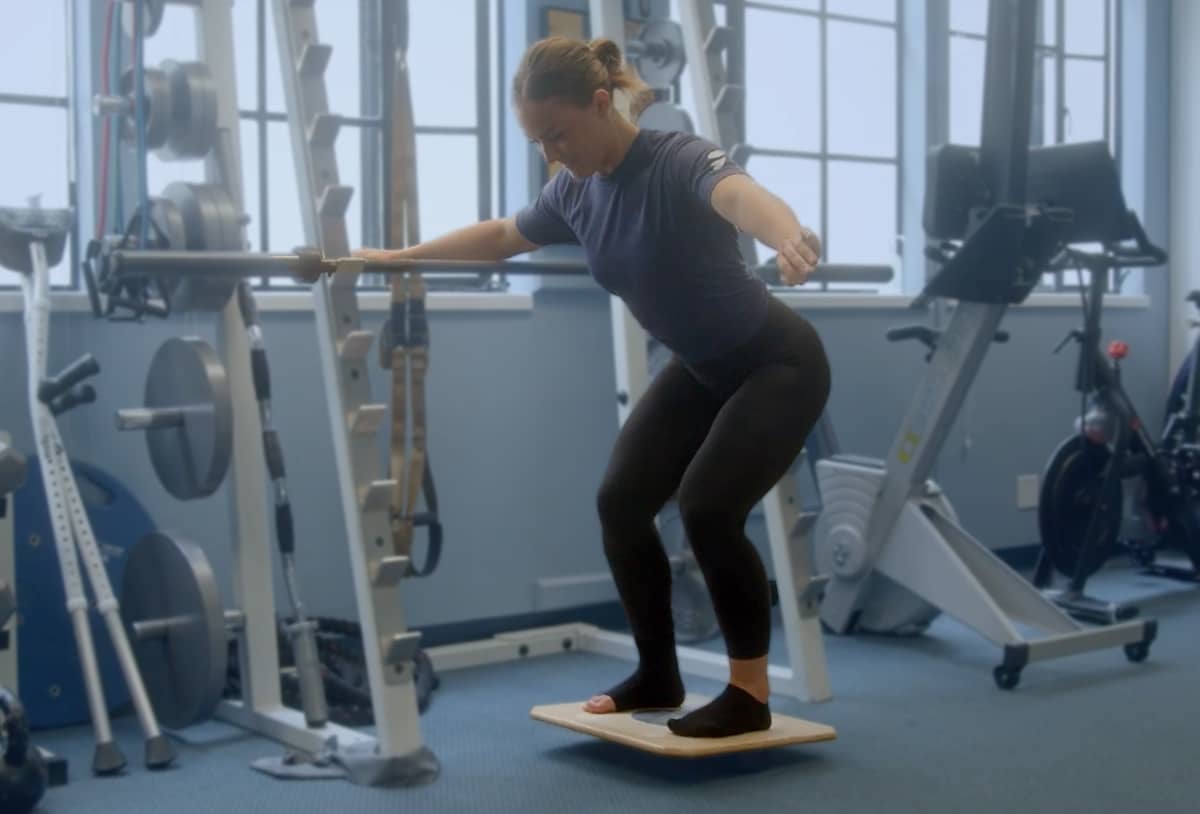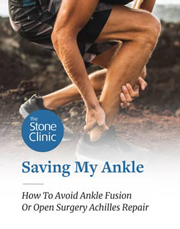Ankle Replacement or Ankle Fusion. Which to Choose?
Ankle fusion is a drastic, last-ditch treatment offered to many people who suffer from ankle arthritis. Improvements in biologic joint replacement and in artificial joint technology may soon make replacement, rather than fusion, the preferred course of action. In this interview with Jeff Greenwald, Dr. Stone explains the difference between the procedures and how to lower the risk of needing these surgeries.

Stone Clinic patient Hannah D, in physical therapy after avoiding ankle fusion with a BioAnkle repair
What is ankle fusion, as opposed to biologic or artificial ankle replacement?
Dr. Kevin Stone: Ankle fusion is where the tibia (the shin bone) and the talus (the bone that sits inside the ankle joint) are screwed together in order to stop any remaining motion between them. This is done in the setting of end-stage ankle arthritis when there is complete deformity of the talus and no hope of regenerative therapies restoring the affected bone-on-bone surfaces.
Biologic joint replacement involves removing the bone spurs and scar tissue often seen after an ankle injury and grafting the damaged tibial and talar surfaces. This can be done using either with our articular cartilage paste graft technique or other cartilage regeneration techniques.
Artificial or bionic ankle replacement is similar to other joint replacements: A metal component is placed cemented onto the distal tibia and a second component with metal and high-molecular-weight polyethlene is cemented onto the top of the talus. Those new surfaces articulate on the polyethylene insert between them providing the patient with a new joint surface.
Under what conditions would a patient choose one instead of the other?
Dr. Kevin Stone: First of all, it's important to note that a very large percentage of people who are told that they need to have an ankle fusion or an ankle replacement, possibly don't. This is because biologic therapies have improved to the point where injections of growth factors and lubrication or biologic replacement with removal of the damaged tissue and grafting of the damaged articular cartilage in the joint provide significant relief for many people with severe ankle arthritis. Biologic joint replacement also delays—or possibly even avoids—the time by which artificial joint replacement or joint fusion is required.
If, however, there's severe damage with deformity of the bones, and biologic therapies have failed, fusing the bones or replacing the surfaces to eliminate the pain is considered.
What are the negatives to an ankle fusion or artificial replacement?
Dr. Kevin Stone: Unfortunately, fusion of one joint—when it's attached to multiple other bones of the foot—always leads to overstress of the adjacent joints in the foot. This eventually causes global degenerative changes in the bone and cartilage of the foot usually associated with pain. But in the short run—since the motion between the worn-out surfaces is eliminated—ankle fusion is a very successful way of eliminating pain since the motion between the worn-out surfaces is eliminated.
Artificial ankle joint replacement is chosen for low-activity people, who have pretty good joint anatomy and require both pain relief and preservation of motion. Ankle replacements have not been widely adopted, however, because of a reasonably high failure rate of ankle replacement designs. The problem is that the entire body weight is loaded onto a relatively small joint. However, the components are getting better and I expect that ankle replacement will continue to improve for selected patients who have the right amount of activity level, optimized weight, and low demands on that joint.
Let’s say someone has a biologic joint replacement, an artificial joint replacement, or a joint fusion. What kinds of activities can they look forward to doing after they’ve healed?
Dr. Kevin Stone: Once a biologic joint replacement heals then a return to full sports—including running—is permitted. The natural tissues adapt to loading, so increased activity leads to stronger bones, muscle, and soft tissues. Artificial ankle replacement permits an increase in walking, biking, and swimming; but not impact exercises, at least, until the implants improve. Excellent joint fusions often provide a high level of ankle activity, without pain, for a number of years. These activities include walking and hiking—but usually not running. And while ankle fusion does work to achieve the goals of diminished pain and increased activity, the possibility of damage to the other parts of the ankle looms in the future.
If somebody has a severe ankle injury—let’s say a basketball player or tennis player— is there any way they can avoid ankle arthritis?
Dr. Kevin Stone: Ankle injuries are similar to injuries in other joints. If the joint is repaired immediately, the anatomy is restored, and the cartilage surface is repaired, these injuries do not usually develop into arthritis. In fact, ankle arthritis is quite rare compared to the frequency of knee, hip, or shoulder joint arthritis.
The bottom line is that, as always, the key for an athlete (or anyone who has an ankle injury) is to have immediate and highly accurate anatomical repair. If there is early arthritic change noted by MRI or x-ray, regular injections of joint lubrication with growth factors may help preserve the joint while diminishing pain and reducing inflammation.
Is joint replacement accomplished with robotic surgery, as it often is with knee surgery?
Dr. Kevin Stone: Not yet. However, on the basis of a CT scan, we can create 3-D reconstructions of the ankle joints which allows us to make models of the joint and place and adjust our repair tissues—or repair devices—based on the anatomy shown in those models.
Can people who have an ankle injury take other courses of action—such as physical therapy—to avoid surgery?
Dr. Kevin Stone: It depends on which tissues are damaged. Physical therapy for ankle injuries is always indicated. We always combine physical therapy with any of our ankle repairs.
There is also a big effort underway to use biologic injections of lubrication— combined with anabolic stimulants, such as PRP—in many ankle problems that involve inflammation, pain, and acute ankle ligament injuries. Such treatments with anabolic stimulation help accelerate healing.
What do you see as the future of treating ankle cartilage injuries?
Dr. Kevin Stone: We are making great progress with biologic joint replacement in the ankle, as we did in the knee joint, using a paste graft technique augmented by anabolic therapies with growth factors. I believe that this will continue to be improved so that, in the future, any significant ankle cartilage injury will be repaired, regenerated, and successfully regrown immediately.
A Patient's Story on Avoiding Ankle Fusion
Hannah traveled to San Francisco, where Dr. Stone repaired the dead bone and cartilage in Hannah's ankle with a cartilage regeneration procedure that he personally developed: the articular cartilage paste graft. Years later, we continue to successfully treat Hannah and help her maintain a full athletic lifestyle outdoors and on the ice.

